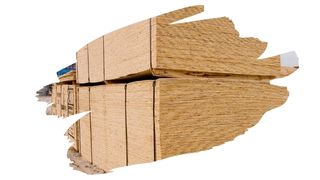What with it’s incredible strength to weight ratio, it’s no secret as to why plywood is widely used for construction. Used to make walls, roofs, and even sub flooring, this engineered wood has great shear strength.
But, what is it that makes exterior grade plywood extra special?
Well, plywood is constructed by gluing wooden veneers together. And, exterior graded ply veneers are typically made from Douglas Fir, a highly rot-resistant durable lumber.
But, more importantly, the glue of this manufactured wood is very water-resistant…and this is where things get interesting.
So, in this post, we dive into why RTD plywood’s manufacturing process makes it more water-resistant than other plywood. You will also discover what really goes into each BCX composite plywood sheet.
And keep reading to find out, once and for all, the key difference between BCX plywood and RTD plywood.

This post may contain affiliate links to products that we receive a commission for (at no additional cost to you). Learn more here.
What Is BCX Grade Plywood?
Well, BCX plywood is actually a composite graded plywood. The letters reflect the different graded plywood sheets used to make this material.
All plywood sheets are given one of four basic quality grades. These grades measure the ‘finished’ quality of the plywood sheet.
The best quality plywood is smooth, sanded, and pretty much as perfect as it gets for plywood. This type of plywood is Graded ‘A’.
The worst quality plywood sheets are riddled with imperfections, and are incredibly rough to the touch. This plywood is Graded ‘D’.
In between, (at ever lowering levels of quality), are B graded plywood and C graded plywood.
Now, a composite graded plywood sheet is made up of two plywood sheets of differing quality.
In the case of BCX plywood, the face (front) sheet is B quality graded plywood. And the back sheet is C grade plywood.
The final letter in BCX plywood refers to the exterior graded glue used to bind those plywood veneers together. The X refers to exterior adhesive. This glue is water-resistant, and doesn’t break down if moisture gets to it.
And What Is BCX Plywood Generally Good For?
It’s used for constructing support structures (specially ones that will not have direct exposure to water).
So, BCX plywood is best suited for high humidity interior areas, (such as wall sheathing, sub-flooring, and roof sheathing). It is not suitable for structures that would have direct exposure to water (such as rainwater).
And What Is Plywood That’s Been Rated RTD?
RTD plywood is a specially engineered type of plywood. Just like BCX plywood, RTD plywood also has water-resistant glue.
But, where these two plywood’s differ, is in the way their glue was treated, at the time of application.
RTD’s special gluing treatment makes it better at avoiding delamination issues. Even more so than BCX ply.
And What Is Delamination?
If moisture gets into plywood glue, it will water-down the adhesive. This then causes the glue to break down, and the ply layers to fall apart.
This breakdown of plywood veneer adhesion is called Delamination.

But What Makes RTD Plywood So Moisture Resistant?
Well, when RTD plywood veneers are glued together, this is done at a precise temperature. Accurate temperature measurement is responsible for this glues increased water-resistant capabilities.
Now, in order to measure this precise temperature, RTD plywood manufacturers use a device called a Resistant Temperature Detector (RTD). And this process makes RTD plywood adhesive capable of shrugging off any possible delamination problems.
In other words, the RTD treatment process makes plywood glue so water-resistant, it can handle very high humidity environments.
Related Post: Can You Use RTD Plywood For Roof Sheathing?
So Can RTD Plywood Get Wet?
The wood used to manufacture exterior graded plywood, (such as BCX and RTD plywood), comes from stable types of wood.
You see generally, if wood gets wet, it can shift around and warp. That’s because wood will soak up water like a sponge, causing wood fibers to expand and swell. And then as that water evaporates afterwards, the wood dry’s out, shrinks, and warps.
However, some wood types are naturally stable, meaning they do not warp if they get wet. For example, Douglas Fir wood is an very stable. It is durable, and rot-resistant.
So, BCX and RTD plywood are made from stable timber, such as Douglas Fir. Plywood made from this timber can get soaked again and again, and never suffer severe warping or wood rot.
So, when it comes to exterior graded plywood, wood rot and warping aren’t an issue. It’s simply delamination that needs to be prevented. And preventing delamination comes down to the quality of that plywood’s adhesive.
Can RTD Plywood Be Used Outside?
It can. But like with BCX plywood, it tends to be used on structures that do not have direct contact with rainwater.
It is best suited for those high humidity spaces, like sub-flooring and sheathing. However, it can take on very damp conditions better than BCX can.
Related Post: What Is BCX Plywood? (Everything You Need To Know)
So Then What’s The Difference Between RTD And BCX Plywood?
Honestly, the key difference lies in the level of humidity each one can take (before delamination becomes an issue). RTD can handle relentless moisture and humidity better than BCX.
Otherwise, the similarities between them outnumber their differences. With the main similarity being that both BCX and RTD do not warp and twist due to humidity.
And both are suitable for sheathing, provided that the plywood sheet also carries the APA sheathing rating.
What Is APA Sheathing Rating?
Well, we know that the grade of BCX refers to the quality of the plywood. And it also lets us know what type of glue has been used to bind its veneers. And RTD refers to the process used to treat the glue of a plywood sheet.
However, neither BCX nor RTD refer to the strength of a given plywood sheet.
You see, not all plywood sheets are made equally strong enough for construction. Only plywood that has the APA ‘SHTG’ stamp on it, will have the shear strength for making walls or roofs.
The APA, (sometimes known as The Engineered Wood Association), are a USA and Canadian trade association. Their organization sets and checks the industry standards for all manufactured wood quality, including plywood. In fact, they used to be known as the American Plywood Association a while back.
Anyway, the APA stamp lets you know that any plywood with this stamp is strong enough for sheathing-related construction.
To Wrap Up, Here Are The 3 Key Takeaways From This Post…
- 1). BCX Plywood is comprised of two different graded plywood sheets. It has then been glued using exterior graded water-resistant glue.
- 2). RTD plywood has been manufactured using a device called a Resistance Temperature Detector.
- 3). RTD plywood’s glue is more water-resistant than the adhesive used on BCX plywood.
References:
APA Rated Sheathing Datasheet | APAWood.org
Resistance Temperature Detector | ScienceDirect.com



